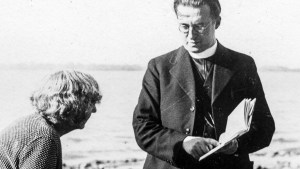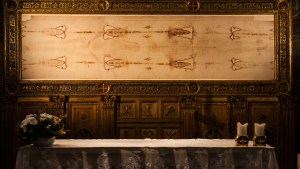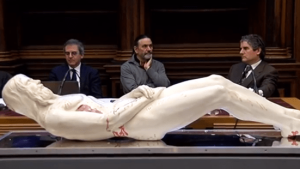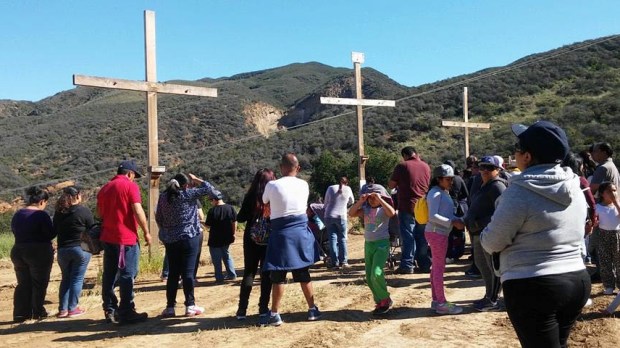Last spring Nicholas Thompson, a Superior Court judge in Orange County, California, visited the Shroud Center of Southern California with a Bible study group. The center was established in 1996 by physician and scientist August Accetta to tell the story of the Shroud of Turin, which many believe to be the burial cloth of Christ.
At the center, groups can examine full size, box-lighted replicas of the 14-foot shroud, both positive and negative images, and view a summation of all the major scientific studies performed on the shroud, which Accetta and center volunteers describe as “the single most studied artifact of all human history.”
Thompson noted that his group of both parents and children “were tremendously impressed and moved by the information presented and the passion [the volunteer guides] demonstrated. The interactive component kept the rapt attention of the kids.”
Referencing a 1988 carbon dating study that suggested that the shroud was a medieval forgery, Thompson continued, “There is ample evidence showing pollen and other plant material laid on the shroud can be dated to the time of Christ and were consistent with Jewish burial practices of the time. Articles still reference the flawed carbon dating study, placing the shroud in the Middle Ages and plant material found within the shroud from areas outside of Jerusalem. These are irrelevant distracters from the multiple layers of compelling evidence that this was the burial cloth of Christ.”
Thompson believes the shroud is a prime example of science supporting faith, noting, “No one can explain the image that remained hidden in the cloth of the shroud until its discovery in the late 19th century.”
The three-dimensional image of the crucified Christ that Thompson references was unknown until 1898, when photographer Secondo Pia was allowed to photograph it and noticed that the negative presented a clearer, more vivid image of Christ.
Joji Taketa, an attorney and catechist at St. Margaret Mary Alacoque Parish in Lomita, took a group of 60 high school students preparing to receive the Sacrament of Confirmation to the center while on retreat at the Santiago Retreat Center in Silverado, where the Shroud Center is currently housed.
Taketa recounted that the presentation on the shroud was the students’ favorite experience on the retreat, noting that the scientific evidence presented in favor of the shroud’s authenticity “graphically brought home to our Confirmation candidates the pain and suffering that Our Lord endured from the lashings on His back, to the nails in His hands, to the crown on His Head.”
Taketa explained how Lee Sweeney, director of the Shroud Center, relates to the students how “an examination of the image on the Shroud indicates Jesus’ resurrection.”
“I have never before heard gasps coming from high school students during any kind of presentation!” the catechist said.
Taketa concluded, “I think for all of us, in particular teens trying to figure out what they believe in, tangible evidence of Jesus’ suffering and resurrection can go a long way.”

Read more:
Bishop Barron takes on the myth that faith and science are enemies
Accetta was raised in a strong Catholic family, but began to question Christianity while in medical school, believing it at odds with the world of science he had embraced. He admitted, however, “I didn’t understand the faith I was leaving.”
He married a Christian and, after extensive study, returned to the practice of the Catholic faith. As a scientist, of special interest to him was the Shroud of Turin, the science of which “fascinated” him. He met other shroud scientists, and opened the Shroud Center of Southern California to share what he’d learned.
Today, the Shroud Center welcomes 50 to 100 visitors per week, who are led on tours by center volunteers. Being at a retreat center is an advantage, explained Sweeney, as many who visit are Confirmation students and school groups on retreat.
“When young people visit and are first introduced to the shroud they can be shocked by what they see,” Sweeney remarked. “What you have is a faint image on an ancient linen cloth. And when you photograph [it] and look at the negative, a three-dimensional image pops out.”
Sweeney continued, “It is unexplained by science. When you see it in our backlit light boxes you can see and understand it so much better than you can if you merely saw it on a book or computer screen.”

Read more:
New study on Holy Shroud confirms: “It’s the blood of a tortured man.”
The center’s timeline allows visitors to trace the history of the shroud, from the 1300s when it first emerges in Europe through various scientific studies that have been done on the shroud since.
In addition to tours, center volunteers host regular events to bring shroud scientists to make presentations, such as an October visit by shroud expert Ian Wilson at the Diocese of Orange’s mother church, Christ Cathedral.
Volunteers are also looking at creating a series of short, educational videos about different aspects of the shroud which will be available through the center’s website.
To tour the center, contact Lee Sweeney at (714) 342-1881 or Leesweeney123@aol.com. There is no cost to visit.

Read more:
This 3D “carbon copy” of Jesus was created using the Shroud of Turin

